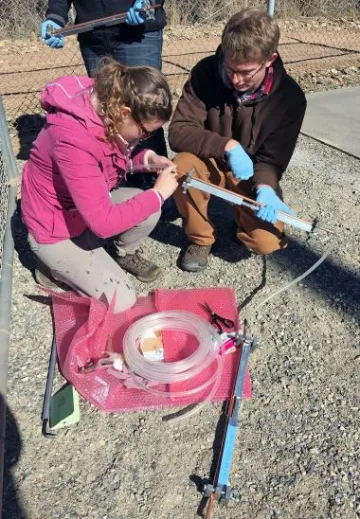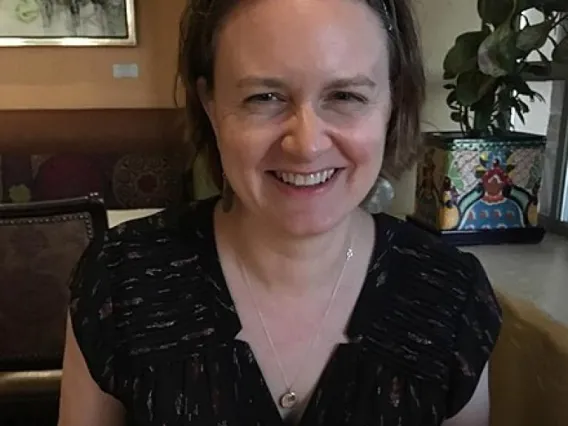Fluid-rock system study can protect potable water sources

PhD students Becca Tyne and Chandler Noyes collecting noble gas samples to date groundwaters in Paradox Valley
December 2020
One of the projects in the multidisciplinary study of the Paradox Basin has provided a practical result for a mining company, as well as further basic science.
There were two goals. One was to find out if a mineralized aquifer near the La Sal Mountains in Utah was isolated from other sources of water used for drinking. If it was, then Lisbon Valley Mine Co. could apply for a permit for in situ recovery of copper at the site. The other was to continue the study’s overall work of mapping the prehistoric fluid-rock system that created mineral deposits and other geologic features.
Eventually, researchers determined that there is negligible water exchange between the mineralized upper Burro Canyon Aquafer and the lower Navajo Aquifer. The evidence was so compelling, the company used portions of the study for its permit request.
The project was led by Jennifer C. McIntosh, a University of Arizona Distinguished Scholar and professor of hydrology and atmospheric sciences and of geosciences, and Mark Person, professor of hydrogeology at the New Mexico Institute of Technology. It’s part of the four-year study on the fluid-rock system of the vast Paradox Basin that straddles Utah, Colorado, New Mexico and Arizona. The W.M. Keck Foundation awarded $1 million for UArizona and New Mexico Tech researchers in different disciplines to understand the 300 million-year history of the basin’s formation.
Mining Company Benefits from Paradox Basin Study
Lisbon Valley Mining provided additional financial support for McIntosh’s team to look at whether the two aquifers were exchanging fluids in the vicinity of the mine. The company’s proposed operation—which would use injection and pumping wells to mine a copper deposit in the Burro Canyon Aquifer—would change the aquifer’s fluids. The company wanted to know if that might affect the Navajo Aquifer, which is tapped for irrigation in the vicinity of the mine and for drinking water in other parts of Utah and Arizona.
“One of the concerns with in situ recovery is you want to make sure that metal-laden solutions are being captured by your pumping well and not going into a potable aquifer,” said McIntosh.
The team took samples of both aquifers, which are separated by the Morrison Formation confining unit. Master’s student Chandler E. Noyes examined ions and isotopes of dissolved minerals in the samples. Person used Noyes’ data to construct a two-dimensional hydrologic and isotopic transport model of the likely water flow and possible fluid exchange over millions of years. “I’m mainly looking at the plumbing of the place,” he said. “We’re able to reproduce what we think is the flow system that could explain Chandler’s data.”
“The plumbing of Paradox Basin is a complex story,”
Mark Person, professor of hydrogeology at NM Institute of Technology
What the model showed was that there is negligible water exchange under natural conditions. Lisbon Mining officials were thrilled with the process and the results. “I was fairly convinced the aquifers were hydraulically separated,” said Lantz M. Indergard, the company’s manager of bioleaching and in situ recovery. Having attended some of the early planning sessions of the Paradox Basin study, Indergard felt his need for confirmation would be a good fit to the overall study.
It turns out that the project provided data beyond what the company could do in-house or without significant cost for an outside effort. Noyes’ thesis so strongly supported Indergard’s assumption and early examination that the company used it in its permit request to state and federal agencies. The company is seeking to exempt the Burro Canyon Aquifer from the Environmental Protect Agency’s underground injection control (UIC) regulation.
If approved, Lisbon Mining could operate extraction wells in the aquifer by 2021 to mine over 500 million pounds of copper deposits. Some open pit mining will continue, but once the in situ recovery is successfully underway, Lisbon Mining will likely transition predominantly to the new operation. “In situ recovery is a much more environmentally friendly way of mining,” Indergard said.
Noyes’ thesis is the basis of a paper co-authored with McIntosh and Person that is under review by the Hydrogeology Journal. McIntosh believes the project highlights a less-expensive method of making sure mining operations mitigate potential environmental challenges. “It’s another tool for our analytical tool box,” she said. Person hopes to use the data to create three-dimensional models that will reveal more about fluid flow through shallow rock formations. He hopes it will add to the story of the Paradox Basin and how minerals got there.


